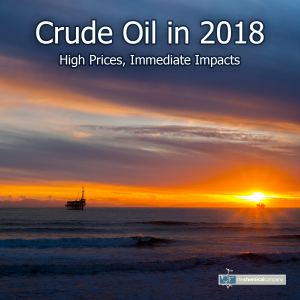In early January 2018, oil prices hit their highest levels in more than three years. “U.S. crude oil inventories are at their lowest level since August 2015. OPEC is getting closer to its target of reducing OECD industrial stocks to the five-year average,” says PVM Oil Associates analyst Tamas Varga.

Data from the U.S. Energy Information Administration showed that crude inventories fell by almost 5 million barrels to 419.5 million barrels in the week of January 5, 2018. This drop is likely due to the extreme cold weather that stopped some onshore output in North America, which was expected to be short-lived. Production cuts led by OPEC and Russia that started in January 2017, and are set to continue throughout 2018, have underpinned charges. There is still downward pressure in the physical market, where the second and third largest OPEC producers have cut their prices to remain competitive.
The oil price decline that began mid-2014, when the price of oil was consistently over $110/bbl, has changed the fundamental economics of the global chemicals industry, and has brought about widespread uncertainty. Additional supply from North American shale oil and continued high production levels from OPEC are likely to make a slow but steady recovery.
Nonetheless, prices will need to recover over time to permit investment in production and exploration. Over the past ten years, oil prices have gone through at least two complete cycles, and more significant swings are likely to happen. During this time of ever-changing prices, setting short and mid-term plans will continue to be necessary.
Oil is one of the key ingredients in the manufacture of various chemicals and related products. Consequently, many chemical firms benefit from lower crude oil prices. However, companies using natural gas as opposed to oil for their feedstock do not enjoy those benefits, resulting in the cost of natural gas affecting chemical firms more than the price of oil in those cases.
Additionally, a substantial decline in crude oil prices would impact the market in other ways. It makes the economics of petroleum substitutes a great deal less attractive, including bio-based and battery chemicals. This issue is causing companies, from global powerhouses to niche firms, to reevaluate their strategies.
Sources:
https://www.cnbc.com/2018/01/10/oil-markets-near-3-year-highs-on-tighter-us-market.html
https://www.icis.com/resources/news/2018/04/10/10210537/us-on-pace-for-record-oil-natgas-production-in-2018/






